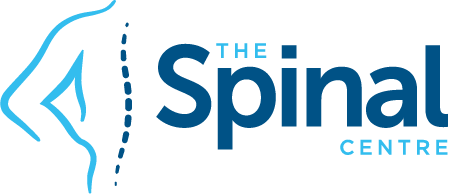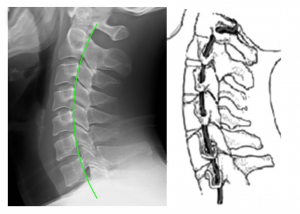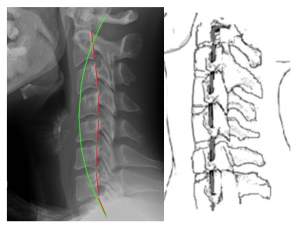
Loss of Neck Curve Reduces Blood Flow to the Brain
Blood flow to the Brain is affected by the curve in your Neck
 Decreased Vertebral Artery Haemodynamics in Patients with Loss of Cervical Lordosis.
Decreased Vertebral Artery Haemodynamics in Patients with Loss of Cervical Lordosis.
An interesting study by Bulut MD et. al. 2016 of relevance to virtually all patients who visit a chiropractor shows a correlation between the curve in your neck and blood flow to the brain.
That is right – the correct curve in your neck allows the blood to flow to your brain in an optimal fashion.
In reality – this kind of makes sense if you think about it.
The cervical spine is designed to have a curve. When we look at the neck from the side a normal sagittal cervical spine has a lordotic curve as shown in the diagram.
The vertebral arteries travel upwards from the aorta of the heart in small windows (transverse foramen) located in the ‘wings’ of the cervical vertebra. The arteries and the vertebral alignment are engineered to be in a nice smooth curve (Harrison DD, 1996 and 2004).
 The two vertebral arteries then join together to become the midline basilar artery which continues to the circle of Willis and cerebral (brain) arteries.
The two vertebral arteries then join together to become the midline basilar artery which continues to the circle of Willis and cerebral (brain) arteries.
Based on the close anatomical relationship between the cervical spine, the vertebral arteries and blood flow to the brain the authors of this study measured changes in neck curve and cerebral vasculature (blood blow).
They speculated that loss of cervical lordosis may affect vertebral artery haemodynamics.
The aim of this study was to compare the vertebral artery values between subjects with and without loss of cervical lordosis.
Their findings where very strong. There was a direct relationship between loss of cervical curve (lordosis) and decreased vertebral haemodynamics.
Indeed, a loss of lordosis resulted in a reduced diameter of the arteries, reduced blood flow to the brain and reduced peak systolic velocity.
The Spinal Centre Comment
 All patients of The Spinal Centre should be aware of the importance of correct alignment of the spine. In particular, the three basic curves in the spine.
All patients of The Spinal Centre should be aware of the importance of correct alignment of the spine. In particular, the three basic curves in the spine.
The neck curve, or cervical lordosis. The mid back curve, thoracic kyphosis. And the lower back curve or lumbar lordosis.
In easy terms, each of the curves is designed and engineered to be around 40 degrees.
Just like blood pressure or blood sugar levels, there is a normal range which is optimal for your health. The evidence now supports that too much curve is a problem as is too little.
This study is important as is correlates the lack of neck curve – which is often a driver for pain and disability – with blood flow to your brain.
This is a very important paper for all people who have neck pain and disability. In our opinion, and based on current evidence, you may need to have the correct X-rays of the spine and measurements taken to assess cervical lordosis (Jackson BL, 1993).
According to current research a normal sagittal cervical spine has a lordotic curve (Bulut, 2016). Loss of neck lordosis, or a reversal of curve – called a kyphosis, is associated with:
- Increased Spinal Cord Nerve Root Tension (McAviney J, 2005 and Moustafa IM, 2011)
- Increased Neck Pain (Moustafa IM, 2015)
- Increased Levels of Pain and Disability in the Neck (Villavicencio AT, 2011, Mustafa IM, 2011/16)
- Poor Health and Poorer quality of life (Mustafa IM, 2016 and Yoon SY, 2018)
- Increased severity of Neck Disc Injuries (Gum JL, 2012 and Gao 2019)
- Increase severity of Lower Back Disc Injuries (Moustafa IM, 2015)
The poor health outcomes and disease processes related to loss of cervical curve originate from prolonged biomechanical stresses and strains in the neural elements (Harrison DD, 2004). Loss of cervical lordosis leads to very large altered stresses to the vertebrae providing the basis for vertebral compression, osteoarthritis, and osteophyte formation consistent with Wolff’s law (Harrison DE, 2001).
In addition to these skeletal changes in the cervical spine, the muscles and soft tissues that support the neck have to work harder to compensate for the biomechanics instability creating soft tissue weakness and damage (Alpayci M, 2016 and Yoon 2018).
Bottom line; maintaining the cervical curve of your neck around 30 to 40 degrees appears to the safest in providing optimal blood flow to your brain.
If there was a drug for this – it would sell like BBQ sausages on a cold day at Bunnings.
Study Details
Decreased Vertebral Artery Haemodynamics in Patients with Loss of Cervical Lordosis.
Published: Med Sci Monit. 2016 Feb 15;22:495-500. Referenced in Pub Med: https://www.ncbi.nlm.nih.gov/pubmed/26876295
Authors: Bulut MD, Alpayci M, Şenköy E, Bora A, Yazmalar L, Yavuz A1, Gülşen İ.
- Department of Radiology, Yuzuncu Yil University, Medical Faculty, Van, Turkey.
- Department of Physical Medicine and Rehabilitation, Yuzuncu Yil University, Medical Faculty, Van, Turkey.
- Department of Physical Medicine and Rehabilitation, Dicle University, Medical Faculty, Diyarbakir, Turkey.
- Department of Neurosurgery, Yuzuncu Yil University, Medical Faculty, Van, Turkey.
BACKGROUND: Because loss of cervical lordosis leads to disrupted biomechanics, the natural lordotic curvature is considered to be an ideal posture for the cervical spine. The vertebral arteries proceed in the transverse foramen of each cervical vertebra.
Considering that the vertebral arteries travel in close anatomical relationship to the cervical spine, we speculated that the loss of cervical lordosis may affect vertebral artery hemodynamics.
The aim of this study was to compare the vertebral artery values between subjects with and without loss of cervical lordosis.
MATERIAL AND METHODS: Thirty patients with loss of cervical lordosis and 30 controls matched for age, sex, and body mass index were included in the study.
Sixty vertebral arteries in patients with loss of cervical lordosis and 60 in controls without loss of cervical lordosis were evaluated by Doppler ultrasonography. Vertebral artery haemodynamics, including lumen diameter, flow volume, peak systolic velocity, end-diastolic velocity, and resistive index, were measured, and determined values were statistically compared between the patient and the control groups.
RESULTS: The means of diameter (p=0.003), flow volume (p=0.002), and peak systolic velocity (p=0.014) in patients were significantly lower as compared to controls. However, there was no significant difference between the 2 groups in terms of the end-diastolic velocity (p=0.276) and resistive index (p=0.536) parameters.
CONCLUSIONS: The present study revealed a significant association between loss of cervical lordosis and decreased vertebral artery hemodynamics, including diameter, flow volume, and peak systolic velocity.
Further studies are required to confirm these findings and to investigate their possible clinical implications.
Scientific References
For a comprehensive list of CBP research; please navigate to Chiropractic BioPhysics Research page.
For journal articles used in the this article; please click on the relevant hyperlink with text or navigate to the Scientific References page.
The Spinal Centre – Neuro-Musculoskeletal SolutionsThe Spinal Centre provides the Best Natural Medicines, Health Products and Nutritional Solutions to Free You of Pain and Improve Your Spinal Health.The Spinal Centre is a leader in the management and treatment of spinal pain and disability including:
- Chronic Back and Neck Pain
- Cervical and Lumbar Disc Injuries with or without neruological changes
- All forms of arthritis including rheumatoid arthritis, psoriatic arthritis and osteoarthritis
- Neurodegenerative diseases such as Parkinson’s and Alzheimer’s disease
- Neuromuscular problems such as chronic back pain, headaches, migraines, neck or spinal pains
- Myofascial pain syndromes such as fibromyalgia, diffuse muscular or joint pains
- Austistic spectrum disorders including ADD, ADHD, learning difficulties and autism
- Fatigue, energy and mood disorders including chronic fatigue and depression
The Spinal Centre focuses on resolution with the development of individualised treatment programs using Conservative and Integrative Medicine; combining genetic, metabolic and nutritional testing with specific natural medicines to enhance your health and achieve your genetic potential.We have helped thousands – Why Not You?





